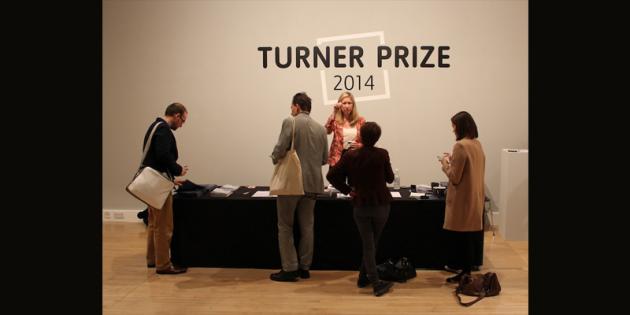Clenching anuses, mass-produced rainbows of wallpaper, pretentious postcolonial posturings, and the ramblings of a nervous madman are what fill the tabloid-titillating Turner Prize in 2014. Or at least, that’s what some would have you believe.
Named after the English Romantic landscape painter JMW Turner, a radical artist in his own day, the annual contemporary arts prize’s raison d’etre is practically to stir up controversy and ergo rouse public interest in the art world. A cursory glance at the Turner Prize’s history reveals its past nominees to be practically a who’s who of polemical work: 1998 featured Tracey Emin’s filth-stained, condom-strewn ‘My Bed’, 2001 saw Martin Creed give two fingers up to conceptual art detractors with his ‘Work No. 227: The lights going on and off’, while 2003 welcomed Jake and Dinos Chapman’s ‘Sex’, a bronze sculpture made to look like blow-up sex dolls.
After a stint at Derry-Londonderry last year, the Turner Prize – created by the Patrons of New Art in 1984 – has returned to it’s spiritual home, the Tate Britain. However, as is generally custom, this 30th birthday has proved a somewhat testing anniversary: does the Turner remain a transgressive teen, or mature with age?
James Richards, a Cardiff-born artist’s works appear to be a middling attempt at the former. The 31 year-old – the youngest of a notably young shortlist – deals with eroticism and censorship in his ‘Rosebud’, initially shown at the 2013 Venice Biennale. This atmospheric video collage incorporates images from Man Ray and Robert Mapplethorpe, found in books from a Tokyo library, with the erogenous zones scratched out, at the same time cut with eerie shots of flowers. Less successful are Richards’ other two works: ‘Untitled Merchandise (Lovers and Dealers)’ (2007) makes oblique reference to AIDS victims through six knitted banners, while ‘The Screens’ (2013) is a bizarre decision: a slideshow of people applying fake wound makeup.
Tris Vonna-Mitchell at least provides a refreshing presence. The Essex-born spoken-word performance artist weaves mesmeric quasi-autobiographical stories, full of repetition and free association. Chosen for Vonna-Mitchell’s 2013 solo exhibition ‘Postscript II (Berlin)’ in Brussels, it tells of a dizzying trip to Berlin in search of his father’s past, with the aid of dual projections. His second piece, the more compelling ‘Finding Chopin: dans l’Essex’ (2014), unravels the artist’s whimsical journey in search of French concrete poet Henri Chopin. “Van Gogh says to Theo in one of his letters: I want to paint solitude,” Vonna-Mitchell intones, on one of his many impassioned spiels, in the vein of the Turner Prize winner Susan Philipsz’s aural work in 2010. Lightboxes filled with images of cream eggs and stationary round of this ritualistic oeuvre pleasingly.
Ciara Phillips is the only nominee to not use any film in her work, instead presenting a brightly-lit room full of colourful abstract prints: blood reds, verdant greens, azure blues, and slithers of brown. Known for her often site-specific works, there are also slogans proclaiming “Ciara, be industrious!”, a giant “OK”, and a robotic voice reading out a list of words. Taking on a Scottish inflection when saying “unity” and “united” is a nice touch, but riff on mechanical reproduction says nothing new. Phillips organises an artist’s collective in Glasgow, inviting local communities to help her work, but while it might make her a good artist, that does not render her screen prints into good art.
Duncan Campbell ‘It For Others’ (2013) is perhaps the most accomplished offering, which is in no small part indebted to French filmmaker Chris Marker’s ‘Statues Also Die’ (1953), about the commercialisation of African art. Campbell explains his search for what Beckett worded as “a form that accommodates the mess”, while self-reflexively reminding us that documentary is fiction. It is slow-paced yet methodical, and deals with the age-old – and still unsolved – topic of how the meanings of objects are manipulated. Perhaps the examples of Marx’s Theory of Value and commodification of are IRA volunteer death are dense and borderline academic, but the means are justified by Campbell’s dry wit and penetrating conclusions. Those who complain of the film’s lengthy 54-minute run time would do well to remember Mark Wallinger’s ‘Sleeper’, an 154-minute film of the artist strolling around in a bear suit, which won in 2007.
This has been a hugely divisive year for the Turner Prize, with every single nominee being variously championed and castigated by different echelons of the press. Glib observers may point to the shortlisting of three artists who use film, as a sign of the times, but no wide-ranging conclusions should be drawn. It is merely cyclical. The more interesting similarity is that three of the artists are alumni of Glasgow School of Art, while only one work had been previously exhibited in London. On the whole, however, it’s difficult to argue that this is a vintage year, though past winner such as Anish Kapoor, Antony Gormley, and Grayson Perry suggest only time will tell. For now, at the Tate Britain – site of the former Millbank prison – as a JMW Turner exhibition is simultaneously on show, Tris Vonna-Mitchell appears to be the breakout.
Words: Peter Yeung Photos: © Artlyst 2014 all rights reserved
Watch Artlyst Turner Prize Vine Here

